Ulysses for iPad - The complete writing solution
(Originally posted on 2015-03-13)

What am I looking for in an iPad writing app?
- For the last year and a half, I have been looking for Ulysses for iPad. The same experience and environment provided by the Mac app on the iPad. That has been my ideal of the perfect writing app for the iPad.
- There is no number 2.
Why? Because Ulysses provides a complete environment for your writing. It is a product which encourages you to write and lets your writing live and grow in it. It is the best designed piece of writing software that I have seen. I love working in it. So, I want the experience replicated on the iPad. I had been using Editorial on the iPad. I like it. It is in my mind, the best text editor on the iPad, but it is not Ulysses. So, I have been pining for Ulysses for iPad.
Finally. Ulysses for iPad is here.
If you are familiar with the Mac version of this application, you are going to be very comfortable with the iPad version. The developers have replicated most of the functionality of the Mac version in the iPad version and the experience is almost seamless.
External keyboard
You can use Ulysses on the iPad by typing on the onscreen keyboard. I am not very fond of that experience. I can use it in a pinch, but most of the time I like having an external keyboard attached to the iPad. If I am in the middle of serious writing, the external keyboard is something that I rely on. You can get one of a whole slew of external keyboards for the iPad. They connect to the iPad through Bluetooth, and they provide you with a full size real keyboard. Makes the process of entering text much more comfortable than the onscreen keyboard. I have used the Logitech Wireless Solar Keyboard K760 for Mac/iPad/iPhone, the Logitech Bluetooth Multi-Device Keyboard K480 for Computers, Tablets and Smartphones, Black and the Logitech Bluetooth Easy-Switch K811 Keyboard for Mac, iPad, iPhone - Silver/Black. All three of these keyboards are multi-device keyboards, in that you can use them with your computer, your iPad and your iPhone. They work very well and they are well made keyboards which feel good to use. I recommend them heartily.
You do have similar benefits from any bluetooth enabled keyboard you want to use. Get one. Makes writing on the iPad a much more elegant experience. In addition, it lets you use keyboard commands. The keyboard bar provided by Ulysses for the iPad is useful but I find keyboard commands more efficient. Also, there are keyboard commands which do not have any equivalents in the onscreen keyboard or the keyboard bar. For instance, ⌃E gets you to the end of the line, and ⌃A gets you to the start of the line that your cursor is on. I find myself using the ⌃E command a lot. On the Mac version, ⌃E gets you to the end of the paragraph you are on, and ⌃A gets you to the start of the paragraph you are on. Very useful, and it works in all your text editors on the Mac.
iCloud Drive
I like Dropbox. I am not very fond of iCloud. At least, I wasn’t very impressed with iCloud till I started beta testing Ulysses for iPad. Now called, iCloud Drive, it works. Yes, surprised the hell out of me, but it works, like it should. In fact, I am writing this document on the iPad and the iMac. The changes I make get reflected in the other device in a few seconds and I can write on the same document on both devices without any glitches. Initially, I thought that the Soulmen folks have done some voodoo on their own to make this work so well, but I am coming around to the realization that iCloud Drive has really improved and the promise of instant syncing is being delivered. Yeah, I am as surprised as you are.
I can start a document in the inbox of iCloud, on either the iPad or the Mac. It appears very soon in the other device. I can edit and work on it, as I feel like, on either device. When I am done, I move it to a folder on the Mac. It is a no friction way of editing and working on a document, irrespective of the device. I find myself utilizing the special talents of both devices. This probably needs an explanation. The experience of using the iPad and the Mac are intrinsically different. On the iPad, I have no distractions, you are effectively on full-screen mode and just writing. It is very good at providing an environment where you write. Just write. I find it easier to edit on the Mac. So after I have the outline and the writing done on the iPad, I edit on the Mac. I also find it easier to add the markdown components to the document on the Mac. Things like links and images are better done on the Mac. You can do them on the iPad, I just find it easier on the Mac, and that is what I find myself doing. The whole process is fluid and I must say that it is very pleasureable. I find myself writing a lot more and hopefully, writing better with this combination.
Keyboard row
Markdown requires you to type a bunch of symbols. Ulysses for the iPad makes it easy for you to type these symbols by providing an extra keyboard row. It contains all the markup you are going to use to write markdown. Press on them and you get a popup list of markup. They are categorized in some way which doesn't seem intuitive to me. I don't really know where is which little code, so when I am using the keyboard row to find something, it is pretty much a hunt and peck search. I know the syntax of markdown enough that I don't find myself going through this exercise often enough to be a pain. If you are starting with markdown, at least on the iPad, you would probably be better off with a cheatsheet than searching for what exactly you are looking for. On the other hand, the markup is there, you just have to find it. Throughout this article I have screenshots of the various pop ups to help you along.
Here comes the first one:

This is the Header pop up. Pretty simple.
Themes and Markup
Ulysses for the iPad like on the Mac, supports a markup called Markdown XL, in addition to regular Markdown. Markdown XL is a variant of markdown which lets Ulysses support annotations, footnotes and attachments. It is the default markup and it is fully supported by the iPad version. You have the choice to use either of Markdown, Markdown XL, Textile’d, a new variant called Minimark, or your own custom markup. I write in Markdown XL or Markdown for the most part. When you start a new document, you are given the choice of specifying the markup you would like in the document, like this,
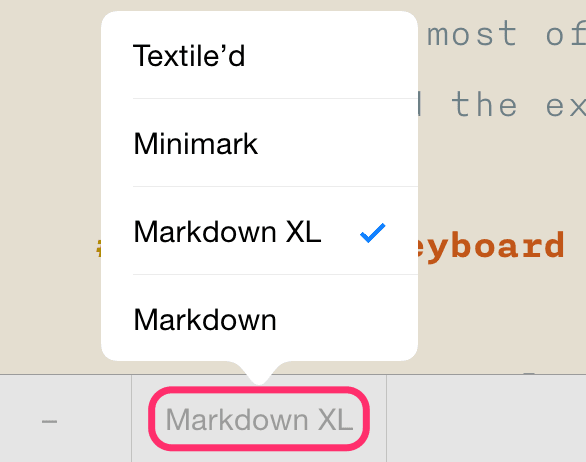
Since we are showing an image, we might as well do another one:
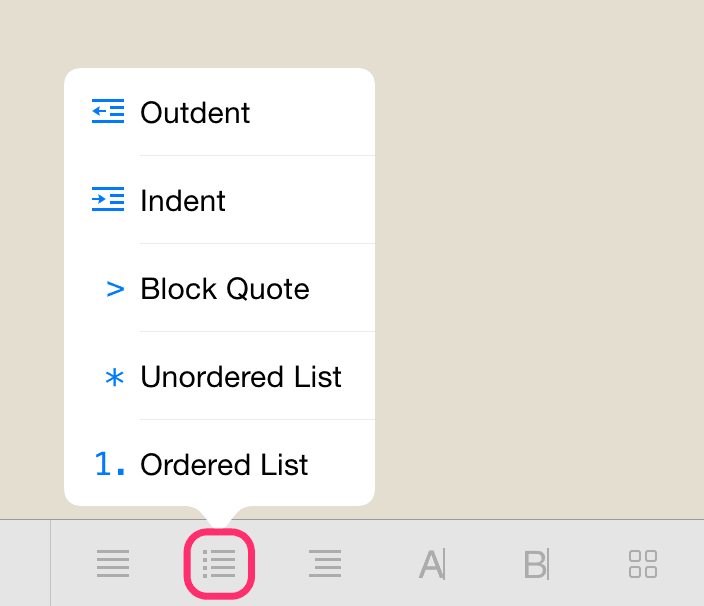
This is the second pop up from the keyboard bar. I understand the icon and it makes me think of lists. I guess I can elaborate that understanding to include indents, outdents and block quotes. It is a stretch, but kind of intuitive.
Ulysses for Mac has lovely themes in-built and there is a whole host of user-contributed themes which are available in the Styles Exchange portion of its website. All the themes which you have installed on the Mac are available to you on the iPad through the magic of iCloud. If you want you can make your own themes through the Mac app. The iPad app doesn’t let you make themes. If you do make your own theme on the Mac, it can be used on the iPad too. You can learn how to make your own themes here.
Adding fonts to Ulysses for iPad
The application lets you access the system fonts in iOS. You also have the ability to add any font you want. I use Nitti. So, on the Mac, I took the whole folder of Nitti and compressed them. I send my email account, the compressed file. On the iPad, in Mail, I just tap and hold on the archived attachment, out pops a window which gives me the options showing what I wanted to do with the attachment, I chose Open in Ulysses. Ulysses on the iPad launches and the active font is Nitti. That is it. That is all I have to do to add fonts to the application.
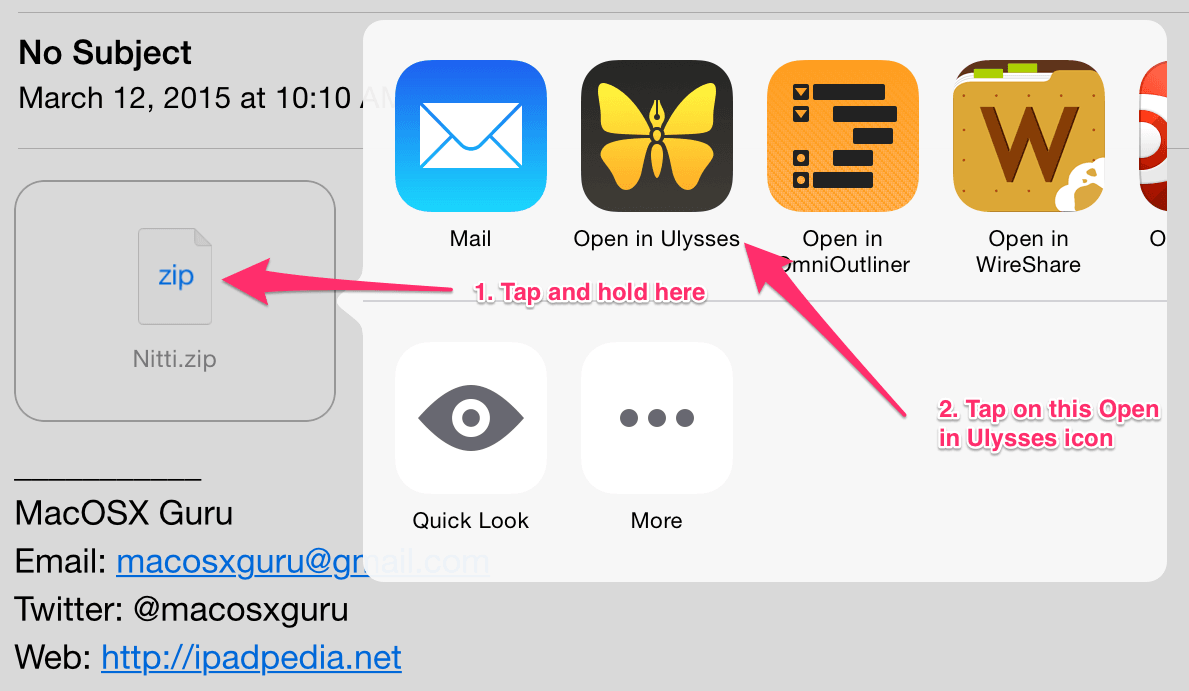
I can have the same result by archiving a font in Dropbox. In Dropbox, I select the file, I tap the share icon, I tap the Open in… icon, I tap Open in Ulysses, and I now get to use the font in Ulysses for the iPad.
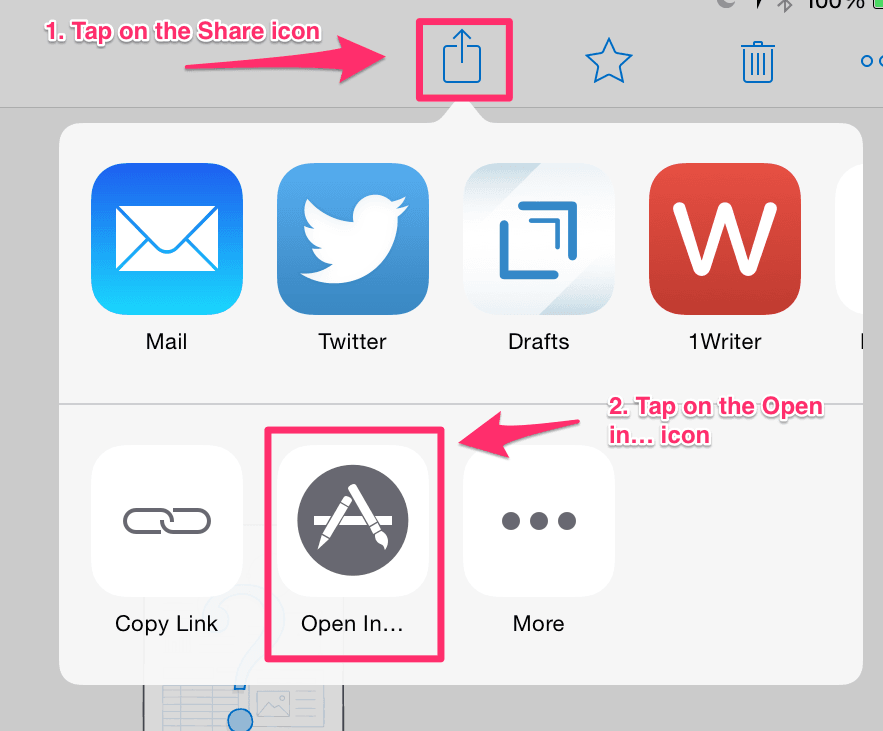
This is the second step:
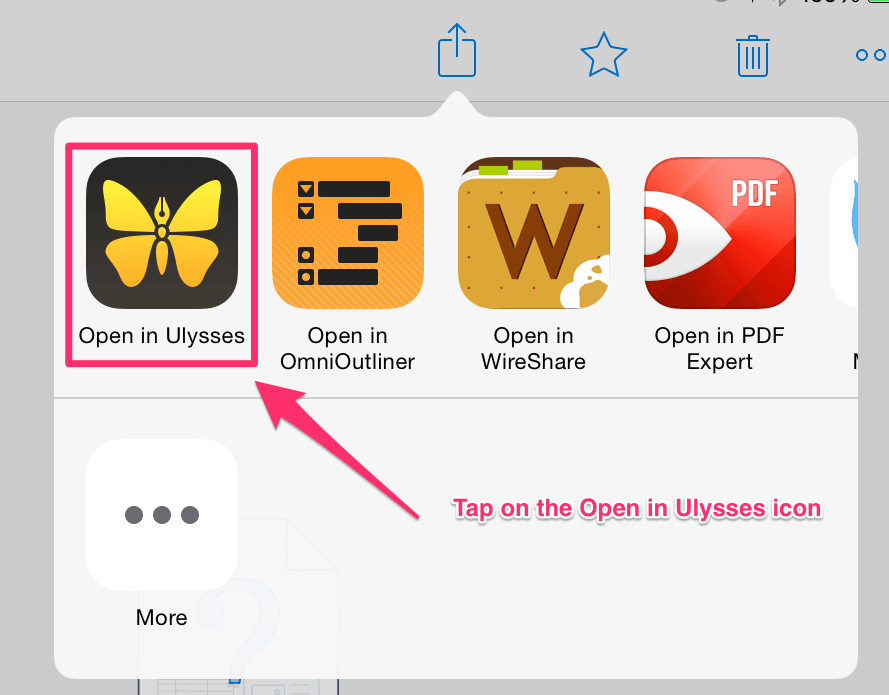
Since we are doing images, might as well add the third one from the keyboard bar.
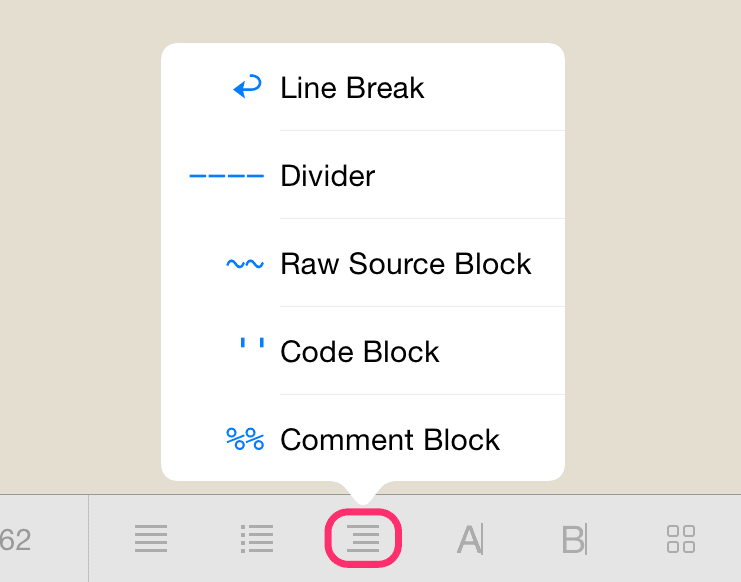
This is where the intuition takes a break. I don’t really know how this collection is intuitive. But it does contain Markdown syntax which are very useful to me. I call it the Misc icon.
A trip through the preferences
Ulysses for the iPad doesn’t have very complicated preferences. They are accessed by clicking on the gear icon at the top of the window.
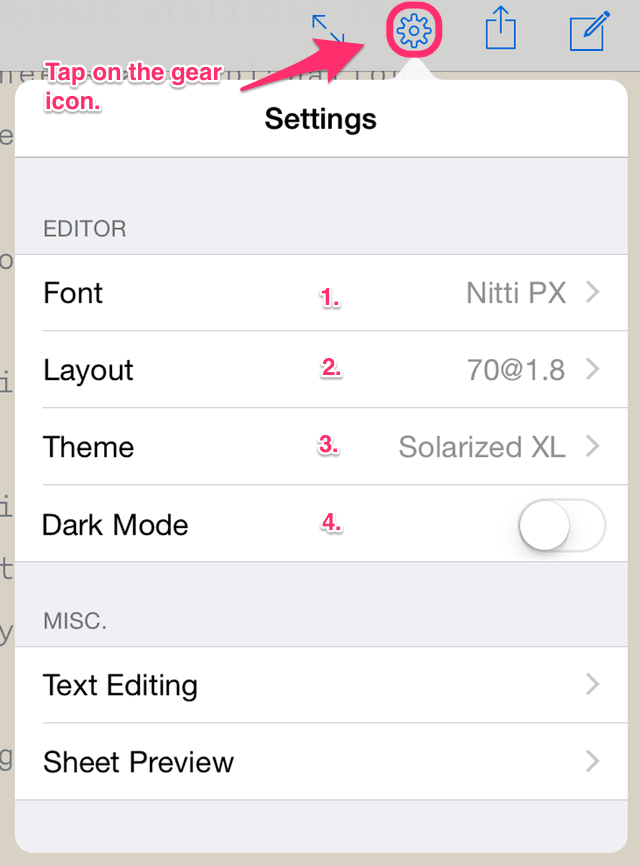
You can do the following things here:
- Set the default font for the document.
- You can choose to restrict the number of characters per line, the space between the lines, the paragraph spacing and the first line indent (if you want any)
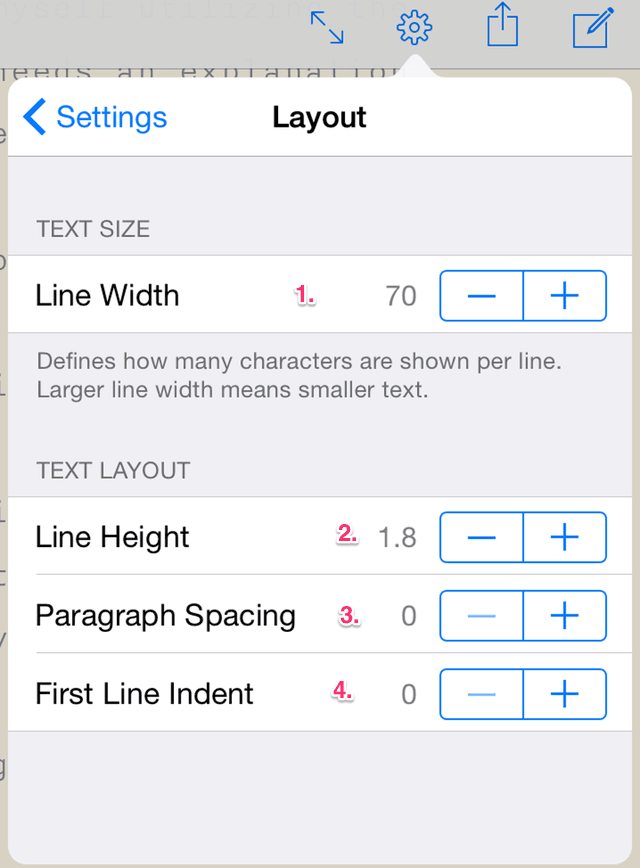
- You can choose the theme you want to use. I find myself using a tweaked copy of Solarized XL all the time.
- You can choose to be in dark mode. One of the advantages of themes for Ulysses is that almost all of them have a dark mode. On the iPad, I spent a lot of time in dark mode, it is a nice way of working.

In text editing options, you have a whole plethora of choices, which are pretty self-evident. The one thing I want to add is the recommendation to use TextExpander 3 + Custom Keyboard. I use it on both the Mac and the iOS devices. It makes writing easier and efficient. I don’t want to write without it.
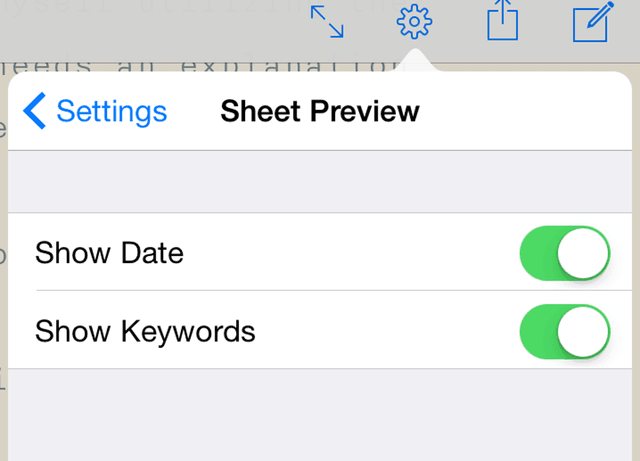
The Sheet preview options define how you want the sheets to be displayed in the sidebar.
That is pretty much it for preferences. So, I am going to do show another icon from the keyboard bar.
This is the A icon:
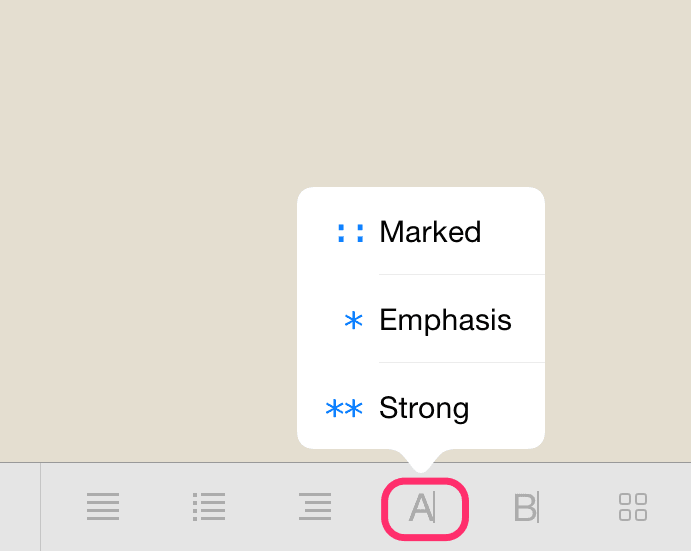
Gives you the ability to mark something, or to turn something into bold(strong) or italic(Emphasis). I use the keyboard commands for this, ⌘b for bold and ⌘i for italic.
A collection of observations
- Ulysses for iPad has complete output options. You get to define the styles of the document type you are outputting to, and it does its thing. You can output plain text, html, ePub, PDF, or RTF. RTF is useful if you use Microsoft Word. So you can write on the iPad and treat the iPad as a complete solution for your output needs too. I write in markdown and tend to output to PDF if I have to share the document with other people. Most of the time, the output stays in markdown, so this output function is nice to have but not intrinsically important to me.
- I have been writing this document for the last three days and of course after I praised iCloud Drive, the whole setup took a major dive. Apple’s Internet offerings were offline for a while. I notice that the reliability of syncing is a little touch and go. I was a part of the beta for this product and most of the discussions online seemed to deal with problems regarding syncing. I haven’t run into them myself but that is a concern for the product. I would prefer it if the developers implemented Dropbox syncing. You have the ability to export your document to a whole host of cloud services like Google Drive, Microsoft OneDrive, Box and even Dropbox. So you are covered in case of emergencies. I have been relying on the Mac version for the last year and a half, and have been in the beta program for the iPad version, and have never lost a document.
- There are people who are very comfortable writing in anything they have in front of them. I read that George R. R. Martin writes in Wordstar. He is quite productive and creative. There are also people who obsess about their writing instruments and find themselves writing less and obsessing more as a result. So, my advice is the following, I love writing in Ulysses for the iPad and Ulysses for the Mac. If you are looking for a tool, you can adopt these and they are going to provide you a gorgeous environment to write in. If you are happy with your tool of choice, why are you reading this review? Get back to writing.
I am going to explain another of the icons in the keyboard bar here:
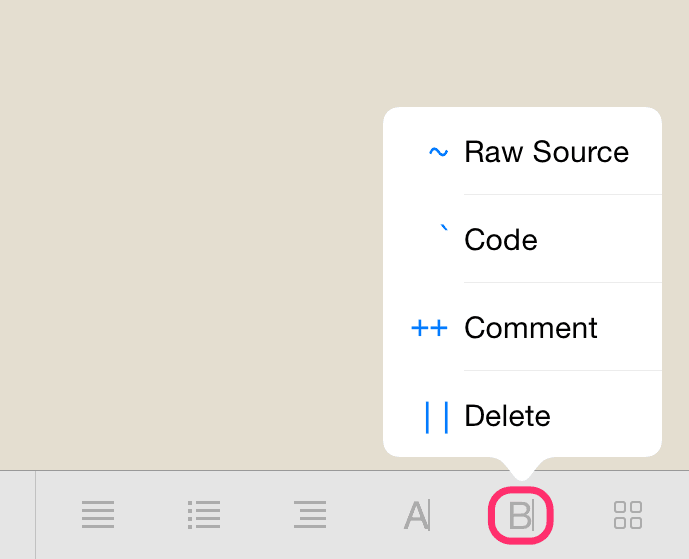
I call this the B icon. It has nothing to do with the markup. Raw Source and Code would probably have been better depicted with the letter C. But Comment and Delete? I don’t know.
I am going to complete the remaining two icons on the keyboard bar here:
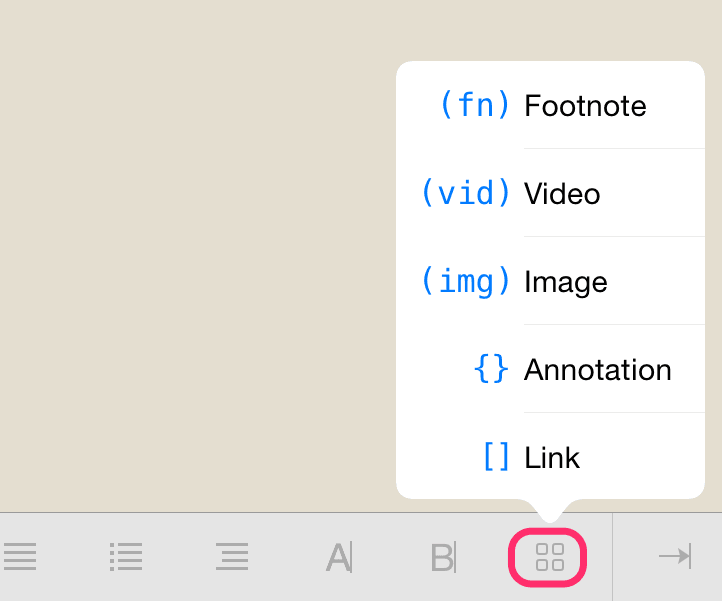
I call this the media icon, and then the markups make sense. You can add a footnote, video, image, Annotation or a link through this icon.
The last one now:

I have no idea what to call this icon. It is in my mind the oops icon. You can Clear Markup and Undo.
I like the fact that the markdown syntax is available in the keyboard bar, however unintuitive it might be. I tried to come up with a better classification scheme or a better notification scheme and I came up empty. So, I am not going to beat up on the Soulmen for this one. I am glad they are available. Thank you.
Recommendations
If you write and are looking for a home for your writing, you cannot go wrong with Ulysses for the iPad and Ulysses for the Mac. They have made my writing life incredibly pleasureable and efficient. I live in these two programs nowadays, and I am ecstatic about it.
I have written about Ulysses for the Mac before, here.
macosxguru at the gmail thingie
Some other takes on Ulysses for iPad
Ulysses for iPad — The Brooks Review
Ulysses gets even better… and an iPad app too | David Hewson
Quick Thoughts on Ulysses for iPad - The Newsprint
Ulysses for iPad: The go-to text editor for long form writing | iMore
Six Colors: Review: Ulysses for iPad and Mac